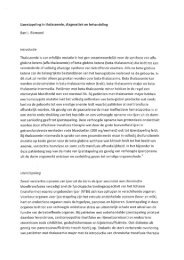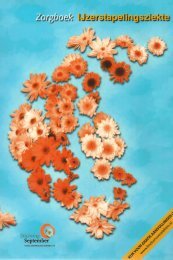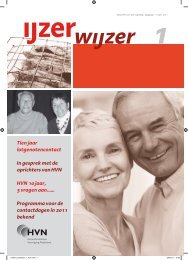Relevance of dietary iron intake and bioavailability in the ...
Relevance of dietary iron intake and bioavailability in the ...
Relevance of dietary iron intake and bioavailability in the ...
Create successful ePaper yourself
Turn your PDF publications into a flip-book with our unique Google optimized e-Paper software.
DIETARY IRON AND HFE HEMOCHROMATOSIS 11 <strong>of</strong> 12a subject with a rare genotype o<strong>the</strong>r than homozygosity for <strong>the</strong> p.Cys282Tyr mutation <strong>in</strong> <strong>the</strong> HFE gene or <strong>in</strong> o<strong>the</strong>r HH-relatedgenes is low because <strong>of</strong> <strong>the</strong> high prevalence <strong>of</strong> p.Cys282Tyrhomozygosity <strong>in</strong> cl<strong>in</strong>ically affected HH patients (25).In HH patients with low to normal <strong>iron</strong> status who consumea typical Western diet that conta<strong>in</strong>s 16–18 mg/d Fe (62), a <strong>dietary</strong><strong>iron</strong> absorption <strong>of</strong> 20–40% for heme <strong>and</strong> nonheme <strong>iron</strong> comb<strong>in</strong>edas shown <strong>in</strong> <strong>the</strong> studied literature would imply a long-termpositive <strong>iron</strong> balance <strong>of</strong> w3–7 mg/d. It is very unlikely that sucha positive balance could be reduced to zero with an exclusive<strong>dietary</strong> <strong>in</strong>tervention. However, a <strong>dietary</strong> modulation may bea useful accessory measure to reduce <strong>the</strong> rapid reaccumulation<strong>of</strong> <strong>iron</strong> <strong>in</strong> cl<strong>in</strong>ically diagnosed HH patients who are undergo<strong>in</strong>ga phlebotomy, especially <strong>in</strong> <strong>the</strong> ma<strong>in</strong>tenance phase. Depletionthrough a phlebotomy <strong>of</strong> HH patients until a very low SF concentration(50 mg/L) is reached (63) will upregulate <strong>the</strong> <strong>iron</strong>absorption <strong>in</strong> HH patients. Therefore, <strong>the</strong> <strong>in</strong>hibition or reduction<strong>of</strong> absorbed <strong>iron</strong> by <strong>dietary</strong> modulation could help to avoidexacerbat<strong>in</strong>g <strong>the</strong> excess release <strong>of</strong> <strong>iron</strong> <strong>in</strong>to <strong>the</strong> circulation,which results <strong>in</strong> a vicious circle <strong>of</strong> more-frequent ma<strong>in</strong>tenancephlebotomies <strong>in</strong> HH patients (20, 64)In conclusion, <strong>dietary</strong> modification may provide an auxiliarymeasure to <strong>in</strong>hibit <strong>iron</strong> accumulation <strong>and</strong> reduce <strong>the</strong> number <strong>of</strong>required phlebotomies <strong>in</strong> cl<strong>in</strong>ically confirmed HH patients. Thisresult could <strong>in</strong>crease <strong>the</strong> patient’s active <strong>in</strong>volvement <strong>in</strong> treatment<strong>and</strong>, as such, may be beneficial for prospective diseaseoutcomes (65). However, additional longitud<strong>in</strong>al research wouldbe required to formulate <strong>and</strong> test an effective <strong>dietary</strong> strategy forthis patient group <strong>and</strong> quantify <strong>the</strong> cl<strong>in</strong>ical benefit <strong>in</strong> <strong>the</strong> number<strong>of</strong> phlebotomies avoided as well as patient wellbe<strong>in</strong>g. Sucha <strong>dietary</strong> strategy would comprise lower<strong>in</strong>g <strong>dietary</strong> <strong>iron</strong> <strong><strong>in</strong>take</strong><strong>and</strong> reduc<strong>in</strong>g <strong>iron</strong> <strong>bioavailability</strong> while ma<strong>in</strong>ta<strong>in</strong><strong>in</strong>g adequate<strong><strong>in</strong>take</strong>s <strong>of</strong> o<strong>the</strong>r essential nutrients that are typically consumed aspart <strong>of</strong> an <strong>iron</strong>-rich diet (ie, z<strong>in</strong>c, vitam<strong>in</strong> C, <strong>and</strong> vitam<strong>in</strong> B-12).We thank Hans Verhoef, Cell Biology <strong>and</strong> Immunology, Wagen<strong>in</strong>gen University,Ne<strong>the</strong>rl<strong>and</strong>s, for <strong>in</strong>-depth advice <strong>and</strong> Irene Gossel<strong>in</strong>k, Science Shop,Wagen<strong>in</strong>gen University, Ne<strong>the</strong>rl<strong>and</strong>s, for logistical support. We are grateful to<strong>the</strong> Dutch Hemochromatosis Society (Nederl<strong>and</strong>se Hemochromatose Vere<strong>in</strong>ig<strong>in</strong>g)for <strong>the</strong> <strong>in</strong>terest <strong>in</strong> <strong>dietary</strong> factors that affect patients with HH.The authors’ responsibilities were as follows—GMvD, DM, <strong>and</strong> AM-B:conducted <strong>the</strong> literature research; DM: wrote <strong>the</strong> first draft <strong>of</strong> <strong>the</strong> manuscript;GMvD, AM-B, <strong>and</strong> DWS: edited <strong>the</strong> manuscript; DM <strong>and</strong> AM-B: hadprimary responsibility for <strong>the</strong> f<strong>in</strong>al content <strong>of</strong> <strong>the</strong> manuscript; <strong>and</strong> all authors:designed <strong>the</strong> study <strong>and</strong> read <strong>and</strong> approved <strong>the</strong> f<strong>in</strong>al manuscript. None <strong>of</strong> <strong>the</strong>authors declared a conflict <strong>of</strong> <strong>in</strong>terest.REFERENCES1. Janssen MC, Sw<strong>in</strong>kels DW. Hereditary haemochromatosis. Best PractRes Cl<strong>in</strong> Gastroenterol 2009;23:171–83.2. Walters GO, Jacobs A, Worwood M, Trevett D, Thomson W. Ironabsorption<strong>in</strong> normal subjects <strong>and</strong> patients with idiopathic hemochromatosis- relationship with serum ferrit<strong>in</strong> concentration. Gut 1975;16:188–92.3. Lynch SR, Skikne BS, Cook JD. Food <strong>iron</strong>-absorption <strong>in</strong> idiopathichemochromatosis. Blood 1989;74:2187–93.4. Sw<strong>in</strong>kels DW, Janssen MCH, Bergmans J, Marx JJM. Hereditary hemochromatosis:genetic complexity <strong>and</strong> new diagnostic approaches.Cl<strong>in</strong> Chem 2006;52:950–68.5. van Bokhoven MA, van Deursen CT, Sw<strong>in</strong>kels DW. Diagnosis <strong>and</strong>management <strong>of</strong> hereditary haemochromatosis. BMJ 2011;342:c7251.6. Merrywea<strong>the</strong>r-Clarke AT, Po<strong>in</strong>ton JJ, Shearman JD, Robson KJ. Globalprevalence <strong>of</strong> putative haemochromatosis mutations. J Med Genet1997;34:275–8.7. Beutler E, Felitti VJ, Koziol JA, Ho NJ, Gelbart T. Penetrance <strong>of</strong>845g/ a (c282y) hfe hereditary haemochromatosis mutation <strong>in</strong> <strong>the</strong>USA. Lancet 2002;359:211–8.8. Allen KJ, Gurr<strong>in</strong> LC, Constant<strong>in</strong>e CC, Osborne NJ, Delatycki MB,Nicoll AJ, McLaren CE, Bahlo M, Nisselle AE, Vulpe CD, et al. Ironoverload-relateddisease <strong>in</strong> HFE hereditary hemochromatosis. N Engl JMed 2008;358:221–30.9. McCune CA. Sex, drugs, <strong>and</strong> “heavy metal”: does diet also matter <strong>in</strong><strong>the</strong> cl<strong>in</strong>ical expression <strong>of</strong> hereditary hemochromatosis? Mayo Cl<strong>in</strong>Proc 2008;83:526–8 .10. Hallberg L, Hulten L, Gramatkovski E. Iron absorption from <strong>the</strong> wholediet <strong>in</strong> men: how effective is <strong>the</strong> regulation <strong>of</strong> <strong>iron</strong> absorption? Am JCl<strong>in</strong> Nutr 1997;66:347–56.11. Sharp PA. Intest<strong>in</strong>al <strong>iron</strong> absorption: regulation by <strong>dietary</strong> & systemicfactors. Int J Vitam Nutr Res 2010;80:231–42.12. Anderson GJ, Frazer DM, McKie AT, Vulpe CD, Smith A. Mechanisms<strong>of</strong> haem <strong>and</strong> non-haem <strong>iron</strong> absorption: lessons from <strong>in</strong>herited disorders<strong>of</strong> <strong>iron</strong> metabolism. Biometals 2005;18:339–48.13. Le Blanc S, Garrick MD, Arredondo M. Heme carrier prote<strong>in</strong> 1transports heme <strong>and</strong> is <strong>in</strong>volved <strong>in</strong> heme-Fe metabolism. Am J PhysiolCell Physiol 2012;302:C1780–5.14. Kroot JJ, Tjalsma H, Flem<strong>in</strong>g RE, Sw<strong>in</strong>kels DW. Hepcid<strong>in</strong> <strong>in</strong> human<strong>iron</strong> disorders: diagnostic implications. Cl<strong>in</strong> Chem 2011;57:1650–69.15. Weiss G. Genetic mechanisms <strong>and</strong> modify<strong>in</strong>g factors <strong>in</strong> hereditaryhemochromatosis. Nat Rev Gastroenterol Hepatol 2010;7:50–8.16. Zoller H, Pietrangelo A, Vogel W, Weiss G. Duodenal metaltransporter(DMT-1, NRAMP-2) expression <strong>in</strong> patients with hereditaryhaemochromatosis. Lancet 1999;353:2120–3.17. Zoller H, Koch RO, Theurl I, Obrist P, Pietrangelo A, Montosi G, HaileDJ, Vogel W, Weiss G. Expression <strong>of</strong> <strong>the</strong> duodenal <strong>iron</strong> transportersdivalent-metal transporter 1 <strong>and</strong> ferroport<strong>in</strong> 1 <strong>in</strong> <strong>iron</strong> deficiency <strong>and</strong><strong>iron</strong> overload. Gastroenterology 2001;120:1412–9.18. Stuart KA, Anderson GJ, Frazer DM, Powell LW, McCullen M,Fletcher LM, Crawford DH. Duodenal expression <strong>of</strong> <strong>iron</strong> transportmolecules <strong>in</strong> untreated haemochromatosis subjects. Gut 2003;52:953–9.19. Zoller H, Theurl I, Koch RO, McKie AT, Vogel W, Weiss G. Duodenalcytochrome b <strong>and</strong> hephaest<strong>in</strong> expression <strong>in</strong> patients with <strong>iron</strong> deficiency<strong>and</strong> hemochromatosis. Gastroenterology 2003;125:746–54.20. van Dijk BA, Laarakkers CM, Klaver SM, Jacobs EM, van Tits LJ,Janssen MC, Sw<strong>in</strong>kels DW. Serum hepcid<strong>in</strong> levels are <strong>in</strong>nately low <strong>in</strong>HFE-related haemochromatosis but differ between C282Y-homozygoteswith elevated <strong>and</strong> normal ferrit<strong>in</strong> levels. Br J Haematol 2008;142:979–85.21. Zimmermann MB, Chaouki N, Hurrell RF. Iron deficiency due toconsumption <strong>of</strong> a habitual diet low <strong>in</strong> bioavailable <strong>iron</strong>: a longitud<strong>in</strong>alcohort study <strong>in</strong> Moroccan children. Am J Cl<strong>in</strong> Nutr 2005;81:115–21.22. Zimmermann MB, Hurrell RF. Nutritional <strong>iron</strong> deficiency. Lancet2007;370:511–20.23. Brissot P, Troadec MB, Bardou-Jacquet E, Le Lan C, Jouanolle AM,Deugnier Y, Loreal O. Current approach to hemochromatosis. BloodRev 2008;22:195–210.24. Adams PC, Barton JC. How I treat hemochromatosis. Blood 2010;116:317–25.25. Feder JN, Gnirke A, Thomas W, Tsuchihashi Z, Ruddy DA, Basava A,Dormishian F, Dom<strong>in</strong>go R Jr, Ellis MC, Fullan A, et al. A novel MHCclass I-like gene is mutated <strong>in</strong> patients with hereditary haemochromatosis.Nat Genet 1996;13:399–408.26. Zimmermann MB, Troesch B, Bieb<strong>in</strong>ger R, Egli I, Zeder C, HurrellRF. Plasma hepcid<strong>in</strong> is a modest predictor <strong>of</strong> <strong>dietary</strong> <strong>iron</strong> <strong>bioavailability</strong><strong>in</strong> humans, whereas oral <strong>iron</strong> load<strong>in</strong>g, measured by stableisotopeappearance curves, <strong>in</strong>creases plasma hepcid<strong>in</strong>. Am J Cl<strong>in</strong> Nutr2009;90:1280–7.27. Sw<strong>in</strong>kels DW, Girelli D, Laarakkers C, Kroot J, Campostr<strong>in</strong>i N, KemnaEH, Tjalsma H. Advances <strong>in</strong> quantitative hepcid<strong>in</strong> measurements bytime-<strong>of</strong>-flight mass spectrometry. PLoS ONE 2008;3:e2706.28. Kroot JJ, Laarakkers CM, Geurts-Moespot AJ, Grebenchtchikov N,Pickkers P, van Ede AE, Peters HP, van Dongen-Lases E, Wetzels JF,Sweep FC, et al. Immunochemical <strong>and</strong> mass-spectrometry-based serumhepcid<strong>in</strong> assays for <strong>iron</strong> metabolism disorders. Cl<strong>in</strong> Chem 2010;56:1570–9.29. Smith PM, Godfrey BE, Williams R. Iron absorption <strong>in</strong> idiopathichaemochromatosis <strong>and</strong> its measurement us<strong>in</strong>g a whole-body counter.Cl<strong>in</strong> Sci 1969;37:519–31.30. Williams R, Manenti F, Williams HS, Pitcher CS. Iron absorption <strong>in</strong>idiopathic haemochromatosis before, dur<strong>in</strong>g, <strong>and</strong> after venesection<strong>the</strong>rapy. BMJ 1966;2:78–81.








